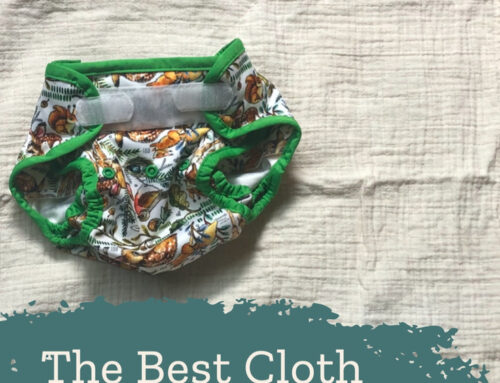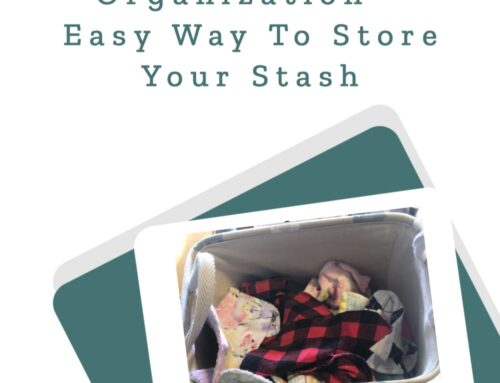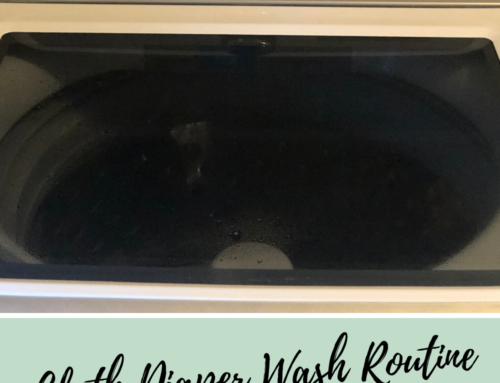This DIY Diapers post contains affiliate links meant to make it easier for you to make diapers from household items. I may receive a commission at no extra cost to you if you purchase after clicking my link.
We are certainly living in some trying times right now. Due to the global pandemic, many people are finding themselves in situations they never envisioned.
Our society is a disposable society. We have a heavy reliance on single-use items (for better or for worse). If you have recently tried to purchase disposable diapers at the store only to find the shelves were running bare, you’re in luck– you can certainly diaper your child with household items you probably already have on hand!
Preparing to Cloth Diaper
Cloth diaper parents were already prepared for the shortages we are seeing in the stores. We already have our reusable diapers at home. As far as toilet paper goes, many cloth diapering families have a bidet installed on one toilet to use for spraying diapers clean. Not all cloth diapering families use a bidet, but if you do and you couldn’t find toilet paper, it has probably come in quite handy!
But if you’re reading this not having any cloth diapers or a bidet, that is just fine. If you are wanting to DIY some cloth diapers but are worried about leaks, the easiest thing to do would be to buy at least a few diaper covers. You don’t have to purchase them if you have the right materials around the house, though. You can make some at home that will work just fine (more on that later).
Covers are the waterproof layer that is on the outside of the cloth diaper. They are not absorbent; they just keep the diapers from leaking. You typically use inserts, prefolds, or flats inside them. Those inners are what collect the urine & waste, and the cover just keeps anything from leaking out onto clothing.
Covers are cheap and you could get by with just a few if you’re willing to handwash them each day (remember, the waste products are on the inserts, NOT the cover. So you can easily handwash quickly in the sink as they shouldn’t be too soiled).
If you would rather not handwash, then I would aim for a minimum of 6-8 covers. Nicki’s Diapers has affordable covers you could check out.
Check out these posts for additional information for successful cloth diapering:
- What Do I Do with the Poop?
- Cleaning Cloth Diapers at Home- Washing Instructions
- Cloth Diaper Laundry Detergent
- How to Wash Cloth Diapers – Is There Only One Way?
Unable to Purchase Covers?
If you want to be 100{9994046f29331ee04cc0b5e07eb28364315ea03ccc2f01b5a43e8b85b372d1e9} DIY, I get it! You can make quality diapers easily from things you have at home. The simplest way to create cloth diapers quickly and cheaply would be to create the following pieces:
- Diaper Covers
- DIY Inners or Inserts – Check out this post for fast & easy DIY inserts
- Cloth wipes (see this post on DIY cloth wipes or just use baby washcloths)
The water-resistant covers are going to be the most work for you to make, but the good news is you don’t need to make a ton of them. I recommend about 6 to start if you’re able, but if you’re just working with what you have readily available at home, then just do what you can do.
There are methods for making them that range from simple & easy, to more complex depending on how customized you want to make these covers.
You will need more diaper inners/inserts per cover (a good rule of thumb is 3 inners per cover), but that is usually the easy part. Check out this post for awesome DIY cloth diaper inserts.
DIY Cloth Diaper Cover Materials
Here are some material ideas for making DIY diaper covers. Directions for creating them will be in the next section.
1. Fleece
If you are making cloth diaper covers in a pinch with limited materials, I recommend starting with fleece. Fleece will probably be the easiest to find around the house because it is cheap and used for lots of things. You probably have a fleece blanket laying around we would be okay with sacrificing if needed.
Fleece makes a great cover material because it doesn’t leak as readily. The pros of fleece covers are that they are super low maintenance and easy to wash and dry. This is perfect for making quick diaper covers.
Fleece isn’t totally leak-proof (and neither are most materials, for that matter). If you are not used to cloth diapers, you will need to get in the habit of changing more frequently than you probably were with disposables. Fleece will leak at some point, as will most materials when they are saturated enough. You need to change before it gets to that point to prevent this from happening.
2. Wool
Dig through your closet for an old wool sweater you are willing to part with. Wool makes an excellent diaper cover because it is breathable, and in general, it can easily be prepared to absorb some moisture from the inner inserts of the diaper without it leaking out. Many people prefer wool to fleece because wool is better at regulating temperature and can absorb some moisture on its own before it leaks.
If you don’t have any wool you’d like to part with, you can always check the thrift store for a cheap, 100{9994046f29331ee04cc0b5e07eb28364315ea03ccc2f01b5a43e8b85b372d1e9} wool sweater. If you can’t get to a thrift store (like now when many of us are on shelter at home orders), it may be best to use fleece right now if that’s what you do have.
Typically, wool covers are hand-washed. However, I’m assuming you have probably been machine washing the sweater you want to make a cover out of. That means it’s likely pre-shrunk, so if you want to just toss in the wash, that’s fine. However, if you are one that is really good about following fabric care rules, then continue to wash the covers the same way you have washed the sweaters, or they will shrink on you!
An old sweater will be felted already (where the wool fibers tighten together), which is awesome for moisture resistance. One thing an old wool sweater will be missing is lanolin. Lanolin is a natural substance produced by sheep that makes their wool anti-bacterial and water resistant. Many people use lanolin for breastfeeding or pumping purposes, so maybe you have some lying around already. This page has some great advice for how to lanolize a wool cover.
Using Your Cover
To use these covers, put it on over the inner piece you make. When it comes time to change, remove the cover and check the wetness. If it isn’t that wet, you can reuse it on the new inner piece right away. If it is wet, set it in a place where it can air dry and grab a new cover. You can alternate covers, allowing them to dry in between, and wash after a few uses.
How To Turn These Materials Into A Cover
Check out this video from Jess is Blessed for how to create a no-sew fleece cover. This is the quickest and easiest option for a diaper cover if you are in a pinch!
As for a wool cover, check out the following tutorial from Cloth Diaper Geek for a super easy way to make a comfy wool cover (requires sewing).
You Can Get By Without Buying Diapers!
DIY cloth diapers are a cheap and convenient solution to a disposable diaper shortage. While purchasing pre-made cloth diapers certainly simplifies everything, there is no reason you can’t be successful with homemade cloth diapers.
Would you try DIY cloth diapers? Let me know in the comments!






Leave A Comment